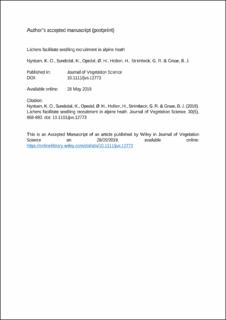Lichens facilitate seedling recruitment in alpine heath
Nystuen, Kristin Odden; Sundsdal, Kristine; Opedal, Øystein Hjorthol; Holien, Håkon; Strimbeck, Richard; Graae, Bente Jessen
Peer reviewed, Journal article
Accepted version
Permanent lenke
https://hdl.handle.net/11250/2652364Utgivelsesdato
2019Metadata
Vis full innførselSamlinger
Originalversjon
Nystuen, K. O., Sundsdal, K., Opedal, Ø. H., Holien, H., Strimbeck, G. R. & Graae, B. J. (2019). Lichens facilitate seedling recruitment in alpine heath. Journal of Vegetation Science, 30(5), 868-880. doi: 10.1111/jvs.12773Sammendrag
Questions How do mat thickness, physical structure and allelopathic properties of terricolous mat‐forming lichens affect recruitment of vascular plants in dwarf‐shrub and lichen heath vegetation? Location The mountains of Dovrefjell, central Norway. Methods In autumn, seeds of ten vascular plant species were collected and sown in a common garden experiment with mats of six lichen species and bare soil controls as experimental treatments. We recorded growing season soil temperature and moisture, and seedling recruitment and growth after one year. The effect of lichen secondary compounds on germination was tested in a growth chamber experiment and compared to the lichen–plant interactions detected under field conditions. Results The lichen mats buffered extreme soil temperatures and soil drying in dry weather, with soils below the thickest mats (Cladonia stellaris and C. rangiferina) experiencing the lowest temperature fluctuations. Seedling recruitment and seedling growth in the field and seed germination in the lab were species‐specific. Seedling recruitment rates were overall higher within lichen mats than on bare soil, but the c. 6.5‐cm‐thick mats of C. stellaris reduced recruitment of many species. The lab experiment suggested no overall strong effect of lichen allelopathy on seed germination, and effects on seed germination were only moderately correlated with the lichen–plant interactions observed for seedling recruitment in the field. Conclusions In harsh environments like alpine dwarf‐shrub and lichen heaths, the presence of lichens and the resulting amelioration of the microclimate seem more important for vascular plant recruitment than are allelopathic effects often reported in lab experiments. We might therefore expect most terricolous lichens, depending on the plant species in focus, to facilitate rather than hamper the early stages of plant recruitment into lichen‐dominated arctic‐alpine heath vegetation.
